Land Suitability Analysis for Forests in Lebanon as a Tool for Informing Reforestation under Climate Change Conditions
Abstract
1. Introduction
1.1. Forests of Lebanon and Climate Change
1.2. Forest Species and Resilience
1.3. Land Suitability and Forest Future
2. Materials and Methods
2.1. Species Selection and Characteristics
2.2. Selected Data for Forest Land Suitability Analysis
2.2.1. Climate Data
2.2.2. Soil and Geographic Data
2.3. Suitability Classification Model Approach
3. Results
3.1. Land Suitability for the Current Period
3.2. Land Suitability under Future Climate Projections
4. Discussion
5. Conclusions
Author Contributions
Funding
Data Availability Statement
Conflicts of Interest
References
- FAO. FAO’s Work on Climate Change. In United Nations Climate Change; FAO: Rome, Italy, 2019; Volume 40. [Google Scholar]
- Masson-Delmotte, V.; Zhai, P.; Pirani, A.; Connors, S.L.; Péan, C.; Berger, S.; Caud, N.; Chen, Y.; Goldfarb, L.; Gomis, M.I. Contribution of Working Group I to the Sixth Assessment Report of the Intergovernmental Panel on Climate Change. Clim. Chang. 2021, 3, 31. [Google Scholar]
- Hansen, M.C.; Potapov, P.V.; Moore, R.; Hancher, M.; Turubanova, S.A.; Tyukavina, A.; Thau, D.; Stehman, S.V.; Goetz, S.J.; Loveland, T.R. High-Resolution Global Maps of 21st-Century Forest Cover Change. Science 2013, 342, 850–853. [Google Scholar] [CrossRef]
- Forestry Economics and Policy Division Food and Agriculture Organization of the United Nations, Global Forest Resources Assessment, Country Report Lebanon, Rome, 2010. Available online: https://www.fao.org/3/al549e/al549e.pdf (accessed on 1 January 2022).
- Sattout, E.; Zahreddine, H. Native Trees of Lebanon and Neighboring Countries: A Guidebook for Professionals & Amateurs; Notre Dame University: Notre Dame, IN, USA, 2013; ISBN 9953-558-47-7. [Google Scholar]
- Khater, C.; El-Hajj, R. Terrestrial Biodiversity in Lebanon; National Council for Scientific Research: Beirut, Lebanon, 2012; pp. 141–169. [Google Scholar]
- Palmer, T.; Ainslie, A. Country Pasture/Forage Resource Profiles. Food Agric. Organ. S. Afr. 2006. Available online: https://ees.kuleuven.be/eng/klimos/toolkit/documents/658_SouthAfrica_English.pdf (accessed on 1 January 2022).
- Ayoub, E.; Jamous, C.; Mhanna, M.; Team, C.; Solano, D.; Plana, E. Lebanon National Forest Program 2015–2025; German Agency for International Development: Bonn, Germany, 2015; Available online: https://faolex.fao.org/docs/pdf/leb163865.pdf (accessed on 1 January 2022).
- Bou Dagher-Kharrat, M.; Abdel-Samad, N.; Douaihy, B.; Bourge, M.; Fridlender, A.; Siljak-Yakovlev, S.; Brown, S.C. Nuclear DNA C-Values for Biodiversity Screening: Case of the Lebanese Flora. Plant Biosyst.-Int. J. Deal. Asp. Plant Biol. 2013, 147, 1228–1237. [Google Scholar] [CrossRef]
- Kelley, C.P.; Mohtadi, S.; Cane, M.A.; Seager, R.; Kushnir, Y. Climate Change in the Fertile Crescent and Implications of the Recent Syrian Drought. Proc. Natl. Acad. Sci. USA 2015, 112, 3241–3246. [Google Scholar] [CrossRef]
- Al-Qaddi, N.; Vessella, F.; Stephan, J.; Al-Eisawi, D.; Schirone, B. Current and Future Suitability Areas of Kermes Oak (Quercus coccifera L.) in the Levant under Climate Change. Reg. Environ. Chang. 2017, 17, 143–156. [Google Scholar] [CrossRef]
- Ministry of Environment. Lebanon’s Second National Communication to the UNFCCC; United Nation Development Program: Beirut, Lebanon, 2011.
- MOE/UNDP/ECODIT. Biodiversity and Forests. In State and Trends of the Lebanese Environment 2010–2011; 2011; Available online: https://www.pseau.org/outils/ouvrages/undp_state_and_trends_of_the_lebanese_environment_2011.pdf (accessed on 1 January 2022).
- Ministry of Agriculture. Strategy 2015–2019, Report, 2014. Available online: https://faolex.fao.org/docs/pdf/leb149670.pdf (accessed on 1 January 2022).
- Jacob, K.; Hudson, S.; Bush, M. Tools for Survival: An Analysis of Financial Literacy Programs for Lower-Income Families; Woodstock Institute: Chicago, IL, USA, 2000; Available online: https://assets.aecf.org/m/resourcedoc/woodstockinstitute-toolsforsurvivalfinancialliteracy-2000.pdf (accessed on 1 January 2022).
- Davis, L.; Johnson, K.; Bettinger, P.; Howard, T. Forest Management: To Sustain Ecological, Economic, and Social Values; McGraw Hill: Waveland, IL, USA, 2005; Volume 804. [Google Scholar]
- Bettinger, P.; Sessions, J. Spatial forest planning: To adopt, or not to adopt? J. For. 2003, 101, 24–29. [Google Scholar]
- MoE/UNDP/GEF. Safeguarding and Restoring Lebanon’s Woodland Resources Project. Socio-Economic Impact Assessment, Lebanon, technical report, 2014. Available online: https://www.undp.org/sites/g/files/zskgke326/files/migration/lb/SRLWR-Project-Final-Report-for-web-LR.pdf (accessed on 1 January 2022).
- Brown, H.; Liu, X.; Pokhrel, R.; Murphy, S.; Lu, Z.; Saleh, R.; Mielonen, T.; Kokkola, H.; Bergman, T.; Myhre, G. Biomass Burning Aerosols in Most Climate Models Are Too Absorbing. Nat. Commun. 2021, 12, 277. [Google Scholar] [PubMed]
- Liu, Y.; Deng, X. Structural Patterns of Land Types and Optimal Allocation of Land Use in Qinling Mountains. J. Geogr. Sci. 2001, 11, 99–109. [Google Scholar]
- Wandahwa, P.; Van Ranst, E. Qualitative Land Suitability Assessment for Pyrethrum Cultivation in West Kenya Based upon Computer-Captured Expert Knowledge and GIS. Agric. Ecosyst. Environ. 1996, 56, 187–202. [Google Scholar] [CrossRef]
- Kalogirou, S. Expert Systems and GIS: An Application of Land Suitability Evaluation. Comput. Environ. Urban Syst. 2002, 26, 89–112. [Google Scholar] [CrossRef]
- Wu, L.X.; Sun, B.; Zhou, S.L.; Huang, S.-E.; Zhao, Q.G. A New Fusion Technique of Remote Sensing Images for Land Use/Cover. Pedosphere 2004, 14, 187–194. [Google Scholar]
- Liu, Y.; Gao, J.; Yang, Y. A Holistic Approach towards Assessment of Severity of Land Degradation along the Great Wall in Northern Shaanxi Province, China. Environ. Monit. Assess. 2003, 82, 187–202. [Google Scholar] [CrossRef] [PubMed]
- Cudlín, P.; Cudlín, P.; Cudlín, P.; Tognetti, R.; Malis, F.; Alados, C.; Bebi, P.; Grunewald, K.; Zhiyanski, M.; Andonowski, V.; et al. Drivers of Treeline Shift in Different European Mountains. Clim. Res. 2017, 73, 135–150. [Google Scholar] [CrossRef]
- Mazahreh, S.; Bsoul, M.; Hamoor, D.A. GIS Approach for Assessment of Land Suitability for Different Land Use Alternatives in Semi Arid Environment in Jordan: Case Study (Al Gadeer Alabyad-Mafraq). Inf. Process. Agric. 2019, 6, 91–108. [Google Scholar] [CrossRef]
- Abdallah, C.; Jaafar, H. Data Set on Current and Future Crop Suitability under the Representative Concentration Pathway (RCP) 8.5 Emission Scenario for the Major Crops in the Levant, Tigris-Euphrates, and Nile Basins. Data Brief 2019, 22, 992–997. [Google Scholar] [CrossRef]
- Chen, I.-C.; Hill, J.K.; Ohlemüller, R.; Roy, D.B.; Thomas, C.D. Rapid Range Shifts of Species Associated with High Levels of Climate Warming. Science 2011, 333, 1024–1026. [Google Scholar] [CrossRef]
- Marchi, M.; Nocentini, S.; Ducci, F. Future Scenarios and Conservation Strategies for a Rear-Edge Marginal Population of Pinus Nigra Arnold in Italian Central Apennines. For. Syst. 2016, 25, e072. [Google Scholar] [CrossRef]
- Liu, Y.-S.; Hu, Y.-C.; Peng, L.-Y. Accurate Quantification of Grassland Cover Density in an Alpine Meadow Soil Based on Remote Sensing and GPS. Pedosphere 2005, 15, 778–783. [Google Scholar]
- Darwish, T.; Zdruli, P.; Saliba, R.; Awad, M.; Shaban, A.; Faour, G. Faour Vulnerability to Desertification in Lebanon Based on Geo-Information and Socioeconomic Conditions. J. Environ. Sci. Eng. B 2012, 1, 851–864. [Google Scholar]
- Karam, F.; Doulis, A.; Ozturk, M.; Dogan, Y.; Sakcali, S. Eco—Physiological Behaviour of Two Woody Oak Species to Combat Desertification in the East Mediterranean-a Case Study from Lebanon. Procedia-Soc. Behav. Sci. 2011, 19, 787–796. [Google Scholar] [CrossRef]
- Douaihy, B.; Tarraf, P.; Stephan, J. Juniperus Drupacea Labill. Stands in Jabal Moussa Biosphere Reserve, a Pilot Study for Management Guidelines. Plant Sociol. 2017, 54, 39–45. [Google Scholar] [CrossRef]
- Stephan, J.; Chayban, L.; Vessella, F. Abiotic Factors Affecting the Distribution of Oaks in Lebanon. Turk. J. Bot. 2016, 40, 595–609. [Google Scholar] [CrossRef]
- Stephan, J.; Bercachy, C.; Bechara, J.; Charbel, E.; López-Tirado, J. Local Ecological Niche Modelling to Provide Suitability Maps for 27 Forest Tree Species in Edge Conditions. IForest-Biogeosciences For. 2020, 13, 230–237. [Google Scholar] [CrossRef]
- Kattar, S.; Rjeily, K.A.; Souidi, Z.; Aoun, G.; Moukarzel, R.; Kallas, G. Evaluation of Land Suitability for Stone Pine (Pinus pinea) Plantation in Lebanon. Int. J. Environ. Agric. Biotechnol. 2017, 2, 563–583. [Google Scholar] [CrossRef] [PubMed]
- Mouterde, P.S.J. Nouvelle Flore Du Liban et de La Syrie; Editions de l’Impr. Catholique: Beyrouth, Lebanon, 2018. [Google Scholar]
- Bozkurt, D.; Sen, O.L. Climate Change Impacts in the Euphrates–Tigris Basin Based on Different Model and Scenario Simulations. J. Hydrol. 2013, 480, 149–161. [Google Scholar] [CrossRef]
- Bozkurt, D.; Turuncoglu, U.; Sen, O.L.; Onol, B.; Dalfes, H.N. Downscaled Simulations of the ECHAM5, CCSM3 and HadCM3 Global Models for the Eastern Mediterranean–Black Sea Region: Evaluation of the Reference Period. Clim. Dyn. 2012, 39, 207–225. [Google Scholar] [CrossRef]
- Giannakopoulos, C.; Kotroni, V.; Lagouvardos, K.; Korakaki, E.; Hatzaki, M.; Tenentes, V.; Roussos, A.; Karali, A.; Goodess, C. Providing Tailored Climate Information to Forest Fire Stakeholders and End-Users. In Proceedings of the EGU General Assembly Conference Abstracts, Vienna, Austria, 7–12 April 2013. [Google Scholar]
- Prasad, M.N.V.; Pietrzykowski, M. Climate Change and Soil Interactions; Elsevier: Amsterdam, The Netherlands, 2020. [Google Scholar]
- Fick, S.E.; Hijmans, R.J. WorldClim 2: New 1-km Spatial Resolution Climate Surfaces for Global Land Areas. Int. J. Climatol. 2017, 37, 4302–4315. [Google Scholar] [CrossRef]
- FAO. A Framework for Land Evaluation: Soils Bulletin; Food and Agriculture Organization of the United Nations: Rome, Italy, 1976. [Google Scholar]
- Hajar, L.; François, L.; Khater, C.; Jomaa, I.; Déqué, M.; Cheddadi, R. Cedrus libani (A. Rich) Distribution in Lebanon: Past, Present and Future. C. R. Biol. 2010, 333, 622–630. [Google Scholar] [CrossRef]
- Cerasoli, S.; Caldeira, M.C.; Pereira, J.S.; Caudullo, G.; De Rigo, D. Eucalyptus Globulus and Other Eucalypts in Europe: Distribution, Habitat, Usage and Threats. Eur. Atlas For. Tree Species 2016, 90–91. Available online: https://w3id.org/mtv/FISE-Comm/v01/e01b5bb (accessed on 1 January 2022).
- Camarero, J.J.; Sánchez-Salguero, R.; Ribas, M.; Touchan, R.; Andreu-Hayles, L.; Dorado-Liñán, I.; Meko, D.M.; Gutiérrez, E. Biogeographic, Atmospheric, and Climatic Factors Influencing Tree Growth in Mediterranean Aleppo Pine Forests. Forests 2020, 11, 736. [Google Scholar] [CrossRef]
- Kim, H.N.; Jin, H.Y.; Kwak, M.J.; Khaine, I.; You, H.N.; Lee, T.Y.; Ahn, T.H.; Woo, S.Y. Why Does Quercus Suber Species Decline in Mediterranean Areas? J. Asia-Pac. Biodivers. 2017, 10, 337–341. [Google Scholar] [CrossRef]
- Baumel, A.; Nieto Feliner, G.; Médail, F.; La Malfa, S.; Di Guardo, M.; Bou Dagher Kharrat, M.; Lakhal-Mirleau, F.; Frelon, V.; Ouahmane, L.; Diadema, K. Genome-wide Footprints in the Carob Tree (Ceratonia siliqua) Unveil a New Domestication Pattern of a Fruit Tree in the Mediterranean. Mol. Ecol. 2022, 31, 4095–4111. [Google Scholar] [CrossRef]
- Kassout, J.; Hmimsa, Y.; El Fatehi, S.; El Ouahrani, A.; Kadaoui, K.; Chakkour, S.; Ariza-Mateos, D.; Palacios-Rodríguez, G.; Navarro-Cerrillo, R.; Ater, M. Image Analysis of Moroccan Carob Seeds (Ceratonia siliqua L.) Revealed Substantial Intraspecific Variations Depending on Climate and Geographic Origin. Ecol. Process. 2022, 11, 34. [Google Scholar] [CrossRef]
- Alemayehu, F.; Taha, N.; Nyssen, J.; Girma, A.; Zenebe, A.; Behailu, M.; Deckers, S.; Poesen, J. The Impacts of Watershed Management on Land Use and Land Cover Dynamics in Eastern Tigray (Ethiopia). Resour. Conserv. Recycl. 2009, 53, 192–198. [Google Scholar] [CrossRef]
- Perrin, A.; Cristobal, M.S.; Milestad, R.; Martin, G. Identification of Resilience Factors of Organic Dairy Cattle Farms. Agric. Syst. 2020, 183, 102875. [Google Scholar] [CrossRef]
- IPCC. Climate Change 2014: Synthesis Report. Contribution of Working Groups I, II and III to the Fifth Assessment Report of the Intergovernmental Panel on Climate Change; IPCC: Geneva, Switzerland, 2014. [Google Scholar]
- Regato, P.; Salman, R. Mediterranean Mountains in a Changing World: Guidelines for Developing Actions Plans; IUCN: Gland, Switzerland, 2008; ISBN 978-2-8317-1058-7. [Google Scholar]
- Rossiter, D.G. A Theoretical Framework for Land Evaluation. Geoderma 1996, 72, 165–190. [Google Scholar] [CrossRef]
- Francis, J.A.; Vavrus, S.J. Evidence Linking Arctic Amplification to Extreme Weather in Mid-Latitudes: Arctic Links to Mid-Latitude Weather. Geophys. Res. Lett. 2012, 39. [Google Scholar] [CrossRef]
- Kelly, A.E.; Goulden, M.L. Rapid Shifts in Plant Distribution with Recent Climate Change. Proc. Natl. Acad. Sci. USA 2008, 105, 11823–11826. [Google Scholar] [CrossRef]
- Lenoir, J.; Gégout, J.C.; Marquet, P.A.; De Ruffray, P.; Brisse, H. A Significant Upward Shift in Plant Species Optimum Elevation During the 20th Century. Science 2008, 320, 1768–1771. [Google Scholar] [CrossRef]
- Parmesan, C. Ecological and Evolutionary Responses to Recent Climate Change. Annu. Rev. Ecol. Evol. Syst. 2006, 37, 637–669. [Google Scholar] [CrossRef]
- Gonzalez, P.; Neilson, R.P.; Lenihan, J.M.; Drapek, R.J. Global Patterns in the Vulnerability of Ecosystems to Vegetation Shifts Due to Climate Change: Global Vulnerability to Climate Change. Glob. Ecol. Biogeogr. 2010, 19, 755–768. [Google Scholar] [CrossRef]
- Hayhoe, K.; Cayan, D.; Field, C.B.; Frumhoff, P.C.; Maurer, E.P.; Miller, N.L.; Moser, S.C.; Schneider, S.H.; Cahill, K.N.; Cleland, E.E.; et al. Emissions Pathways, Climate Change, and Impacts on California. Proc. Natl. Acad. Sci. USA 2004, 101, 12422–12427. [Google Scholar] [CrossRef] [PubMed]
- Ducrey, M.; Huc, R.; Ladjal, M.; Guehl, J.-M. Variability in Growth, Carbon Isotope Composition, Leaf Gas Exchange and Hydraulic Traits in the Eastern Mediterranean Cedars Cedrus libani and C. Brevifolia. Tree Physiol. 2008, 28, 689–701. [Google Scholar] [CrossRef][Green Version]
- Bolte, A.; Ammer, C.; Löf, M.; Nabuurs, G.-J.; Schall, P.; Spathelf, P. Adaptive Forest Management: A Prerequisite for Sustainable Forestry in the Face of Climate Change. In Sustainable Forest Management in a Changing World: A European Perspective; Spathelf, P., Ed.; Managing Forest Ecosystems; Springer: Dordrecht, The Netherlands, 2009; Volume 19, pp. 115–139. ISBN 978-90-481-3300-0. [Google Scholar]
- Milad, M.; Schaich, H.; Konold, W. How Is Adaptation to Climate Change Reflected in Current Practice of Forest Management and Conservation? A Case Study from Germany. Biodivers. Conserv. 2013, 22, 1181–1202. [Google Scholar] [CrossRef]
- Llanderal-Mendoza, J.; Gugger, P.F.; Oyama, K.; Uribe-Salas, D.; González Rodríguez, A. Climatic Determinants of Acorn Size and Germination Percentage of Quercus Rugosa (Fagaceae) along a Latitudinal Gradient in Mexico. Bot. Sci. 2017, 95, 37–45. [Google Scholar] [CrossRef]
- Mojzes, A.; Ónodi, G.; Lhotsky, B.; Kalapos, T.; Csontos, P.; Kröel-Dulay, G. Within-Generation and Transgenerational Plasticity in Growth and Regeneration of a Subordinate Annual Grass in a Rainfall Experiment. Oecologia 2018, 188, 1059–1068. [Google Scholar] [CrossRef]
- Skov, F.; Svenning, J.-C. Potential Impact of Climatic Change on the Distribution of Forest Herbs in Europe. Ecography 2004, 27, 366–380. [Google Scholar] [CrossRef]
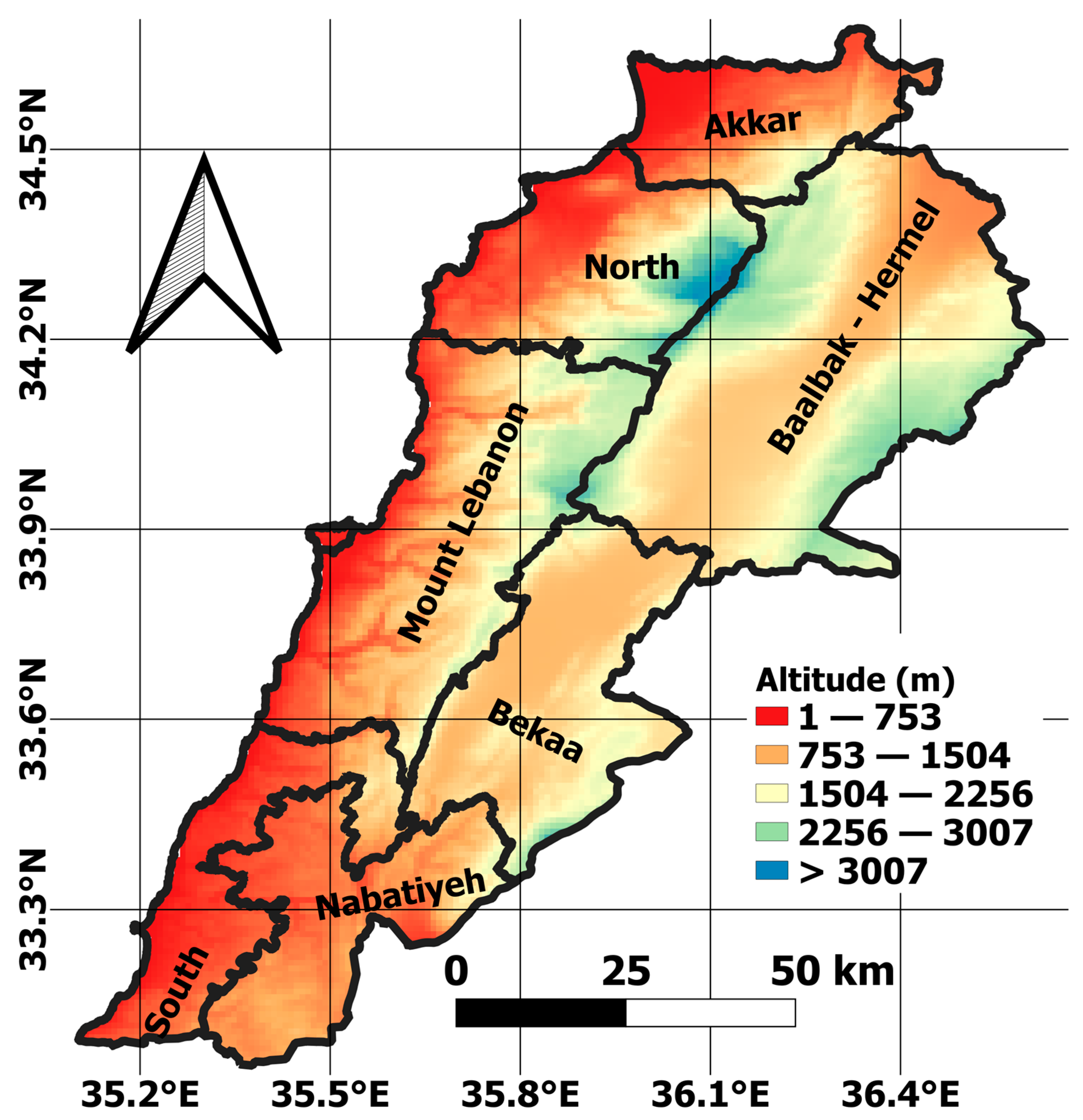
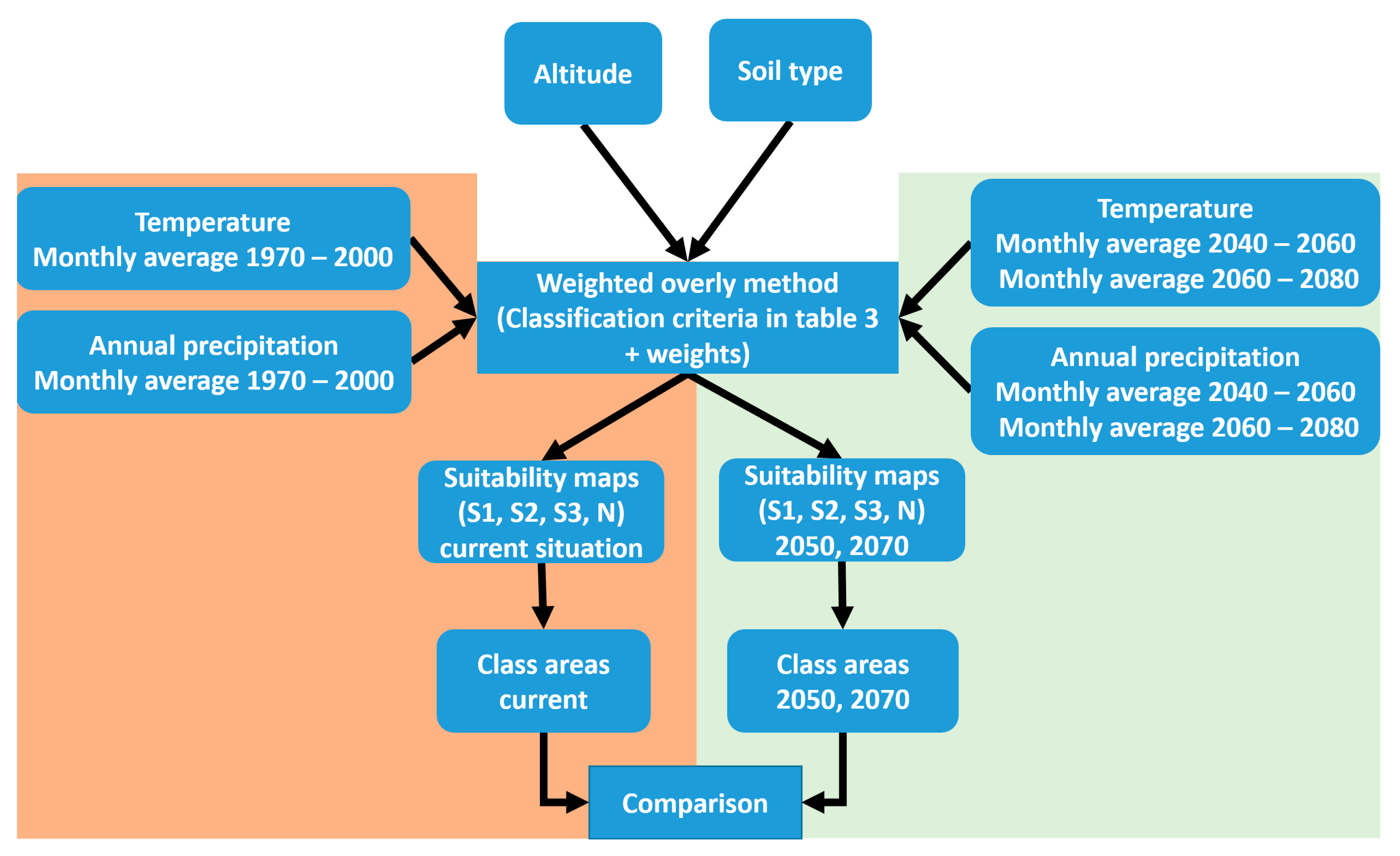
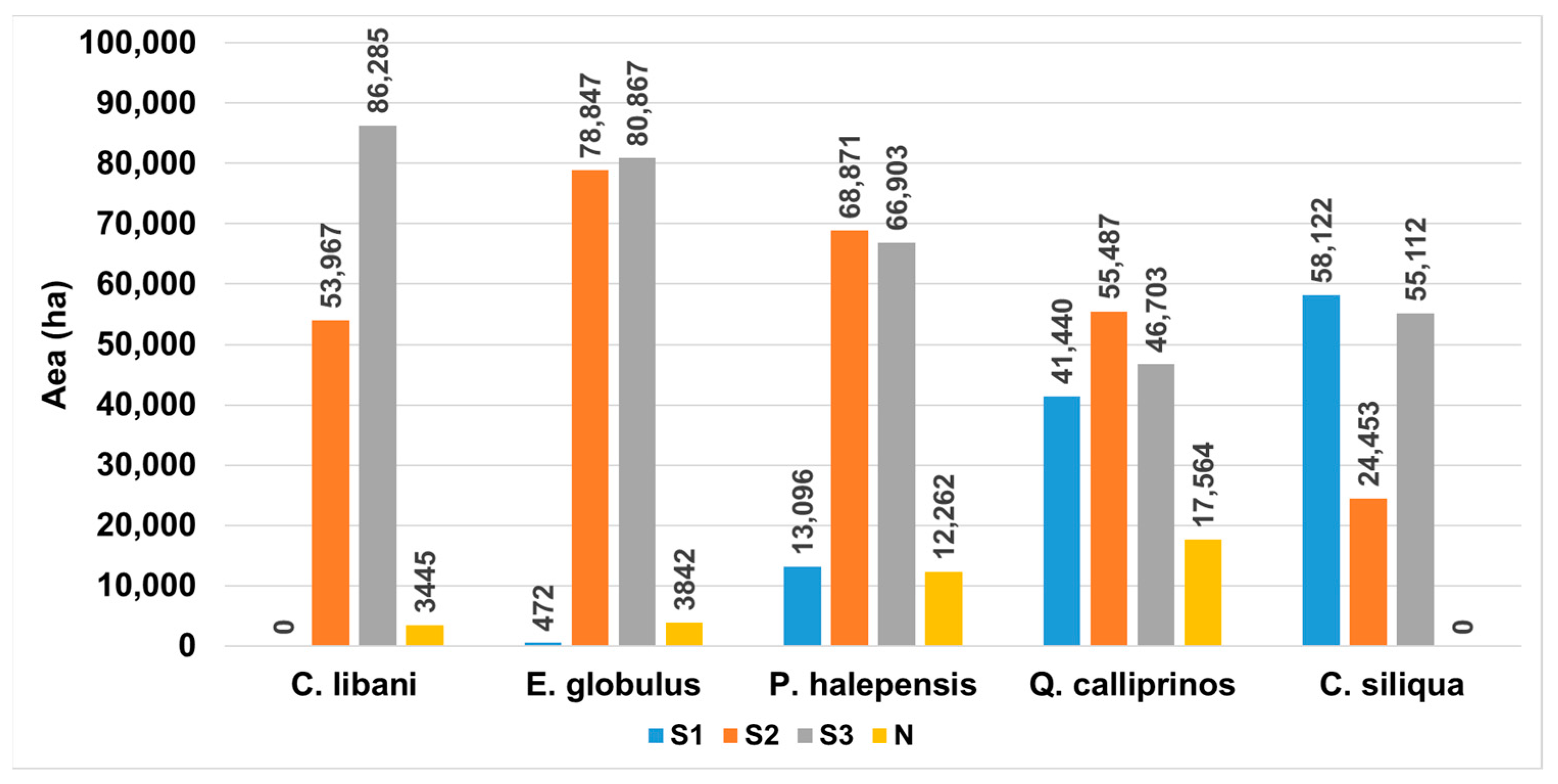
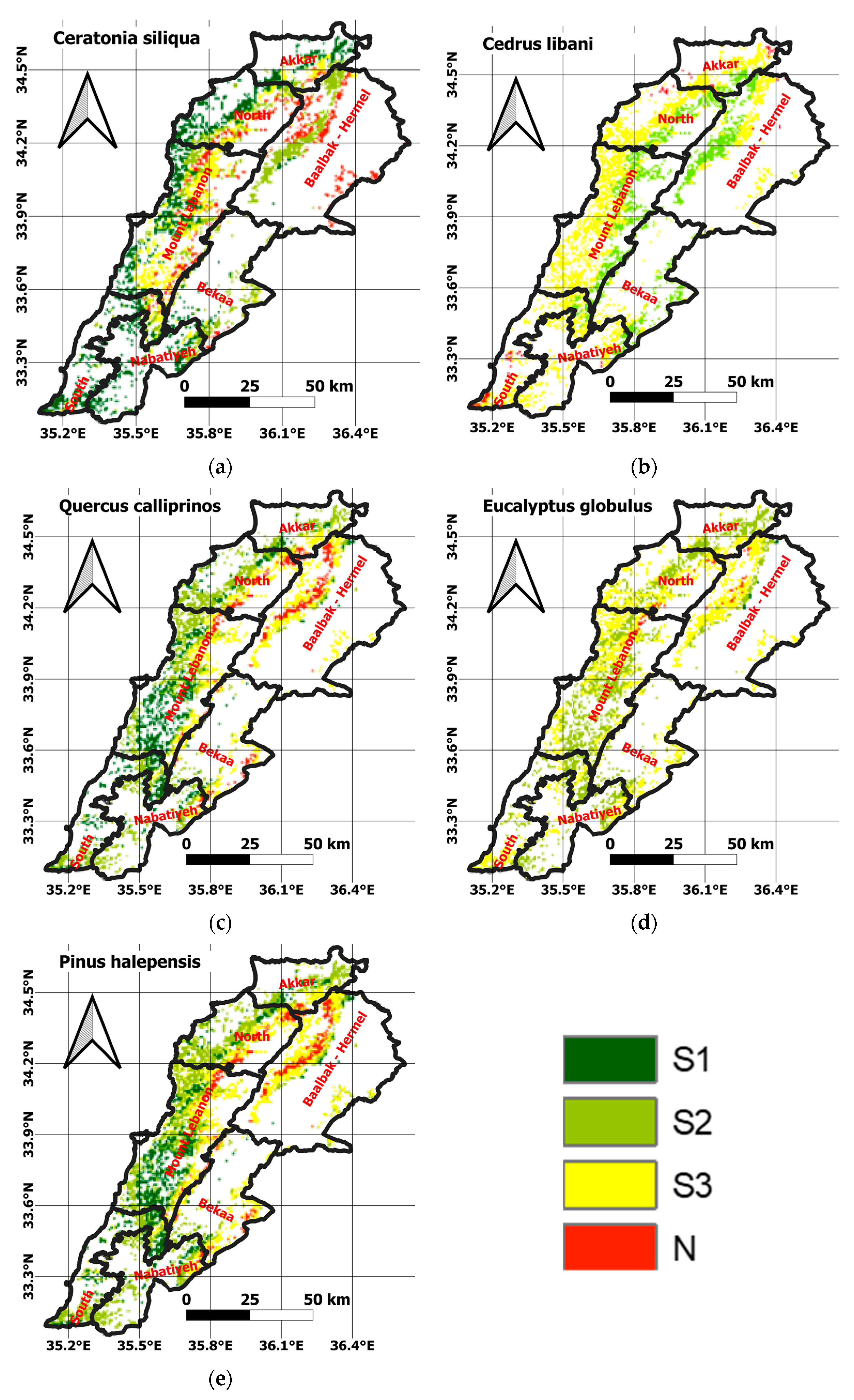
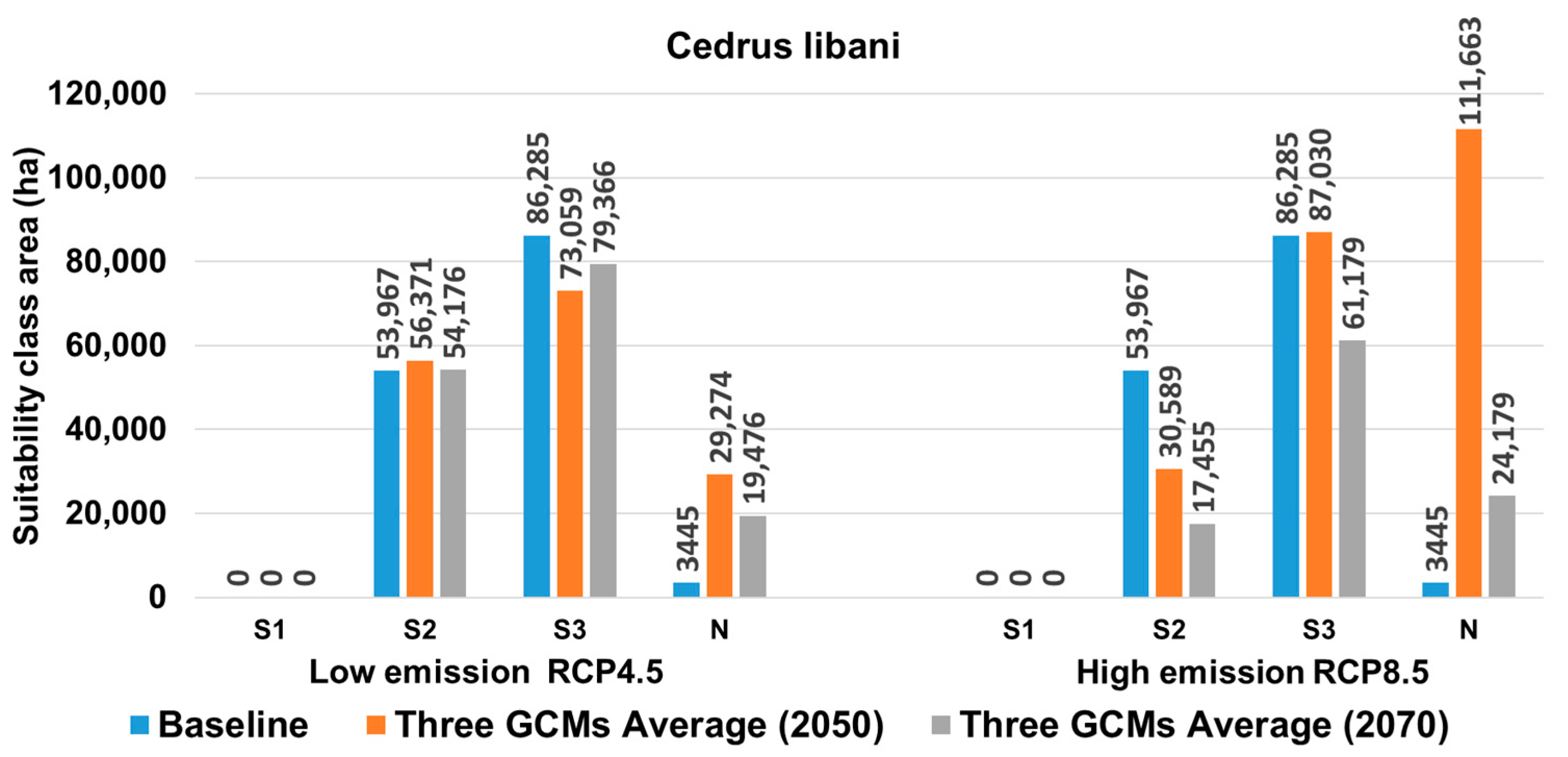

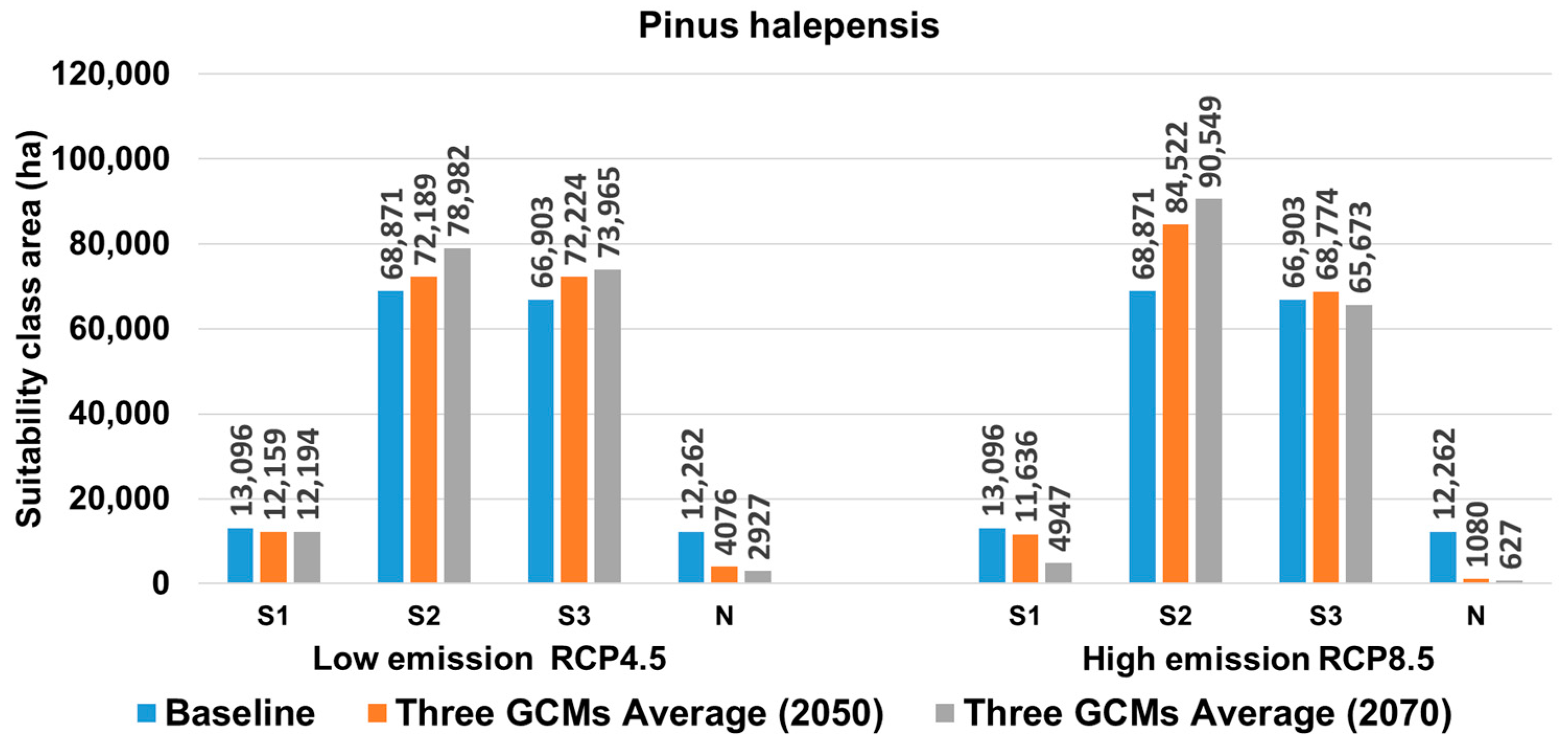


| Species | English Name | Average Height | Flowering Period | Fruiting Period | Altitude | Vegetation Level | Dominant Soil Type |
|---|---|---|---|---|---|---|---|
| Cedrus libani | Lebanese cedar | 30–40 m | Oct.–Nov. | Autumn | 1200–2000 m | Mon-M | Calcareous soil |
| Ceratonia siliqua | Carob | <10 m | July–October | Sept.–Oct. | 0–1000 m | T-M and Eu-M | Calcareous soil |
| Pinus halepensis | Aleppo pine | 15–25 m | April–May | Sept.–Oct. | 0–1500 m | T-M and Eu-M | Marl-calcareous |
| Quercus calliprinos | Gall oak | <10 m | March–April | Autumn | 500–800 m | Eu-M | Calcareous soil |
| Eucalyptus globulus | Tasmanian blue gum | 40–55 m | May | September | 0–1300 m | T-M and Eu-M | Calcareous soil |
| Climate Model | Representative Concentration Pathways | 1970–2000 | 2050 | 2070 |
|---|---|---|---|---|
| Climate research unit | x | |||
| CCSM4 | RCP4.5 | x | x | |
| RCP8.5 | x | x | ||
| GFDL-CM3 | RCP4.5 | x | x | |
| RCP8.5 | x | x | ||
| HadGEM2-ES | RCP4.5 | x | x | |
| RCP8.5 | x | x |
| Species | Land Suitability | Altitude (m) | Temperature Range (°C) | Annual Precipitation (mm) | Soil Type |
|---|---|---|---|---|---|
| Cedrus libani | S1 | 1200–2000 | 3–9 | 1371–1906 | Calcareous |
| S2 | 600–1200 | 9–15 | 1200–1349 | Calcareous limestone | |
| S3 | 500–600 | 15–23.4 | 692–1026 | Sandy | |
| N | >2400 | <−7 and >23.5 | |||
| Eucalyptus globulus | S1 | 500–1000 | 12–18 | 600–1100 | Sandy-clay |
| S2 | 0–500 | 18–25 | 1100–1600 | Sandy-loam | |
| S3 | 1000–1500 | −5–12 | 500–600 | Clay | |
| N | <−5 and >30 | <500 | Calcareous | ||
| Pinus halepensis | S1 | 500–800 | 14.5–19.3 | 350–700 | Sandy, |
| S2 | 800–1000 | 0.4–14.5 | 700–1000 | Loamy soil | |
| S3 | 0–500 | 19.3–32.6 | 182–350 | Dry soil | |
| N | <−5 and >35 | ||||
| Quercus calliprinos | S1 | 100–500 | 7.2–21 | 400–800 | Limestone soils |
| S2 | 500–1000 | 21–40 | 800–1295 | Calcareous limestone | |
| S3 | 1000–1500 | −5–7.2 | 300–400 | All types of soils | |
| N | <−5 | ||||
| Ceratonia siliqua | S1 | 0–300 | 15–20 | 550–1100 | Calcareous |
| S2 | 300–500 | 20–32 | 250–550 | Alluvial | |
| S3 | 500–800 | 7.8–15 | 1100–1300 | Rocky | |
| N | <800 | <−4 | 250–1300 |
Disclaimer/Publisher’s Note: The statements, opinions and data contained in all publications are solely those of the individual author(s) and contributor(s) and not of MDPI and/or the editor(s). MDPI and/or the editor(s) disclaim responsibility for any injury to people or property resulting from any ideas, methods, instructions or products referred to in the content. |
© 2023 by the authors. Licensee MDPI, Basel, Switzerland. This article is an open access article distributed under the terms and conditions of the Creative Commons Attribution (CC BY) license (https://creativecommons.org/licenses/by/4.0/).
Share and Cite
Jezzini, N.; Nassif, N.; Mereu, V.; Faour, G.; Hassoun, G.; Mulas, M. Land Suitability Analysis for Forests in Lebanon as a Tool for Informing Reforestation under Climate Change Conditions. Forests 2023, 14, 1893. https://doi.org/10.3390/f14091893
Jezzini N, Nassif N, Mereu V, Faour G, Hassoun G, Mulas M. Land Suitability Analysis for Forests in Lebanon as a Tool for Informing Reforestation under Climate Change Conditions. Forests. 2023; 14(9):1893. https://doi.org/10.3390/f14091893
Chicago/Turabian StyleJezzini, Noura, Nadine Nassif, Valentina Mereu, Ghaleb Faour, Georges Hassoun, and Maurizio Mulas. 2023. "Land Suitability Analysis for Forests in Lebanon as a Tool for Informing Reforestation under Climate Change Conditions" Forests 14, no. 9: 1893. https://doi.org/10.3390/f14091893
APA StyleJezzini, N., Nassif, N., Mereu, V., Faour, G., Hassoun, G., & Mulas, M. (2023). Land Suitability Analysis for Forests in Lebanon as a Tool for Informing Reforestation under Climate Change Conditions. Forests, 14(9), 1893. https://doi.org/10.3390/f14091893







